Common trees that start with the letter “S” include Satinleaf, Sandalwood, Sapodilla, Seagrape, Sycamore, Spruce, Sweetgum, Silver Maple, Serviceberry, and Sitka Spruce. Read on to learn more about these amazing trees!
Trees are some of the oldest things on earth, and humans have relied on trees for all sorts of things over the centuries. Today, we are going to take a look at tree categories that aren’t related by leaf shape or fruit but by the alphabet! Here is our list of 10 Amazing trees that start with the letter “S,” plus a more complete list of tons of other trees out there that start with the letter “S.”
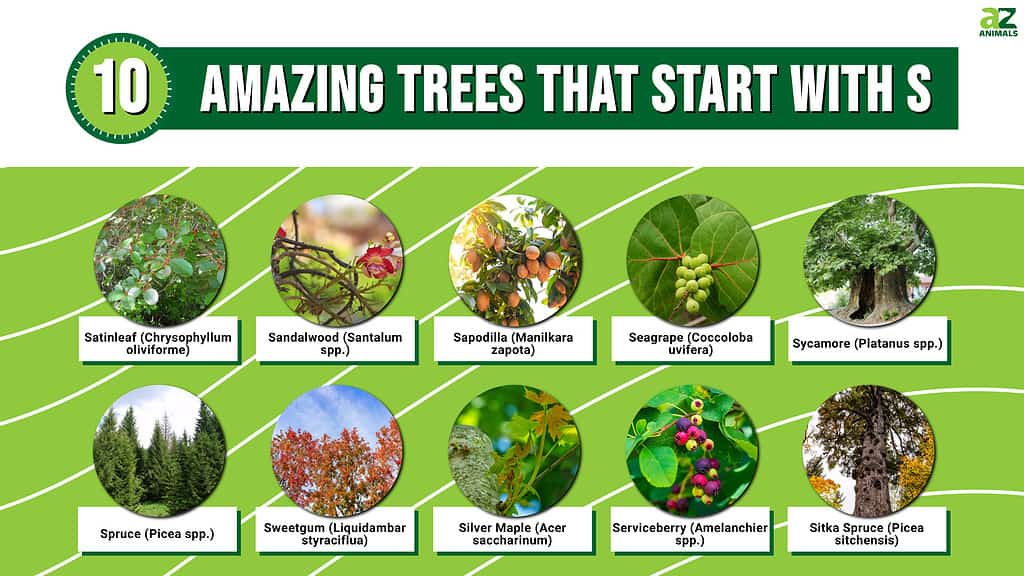
10 Trees That Start With the Letter S
Satinleaf (Chrysophyllum oliviforme)
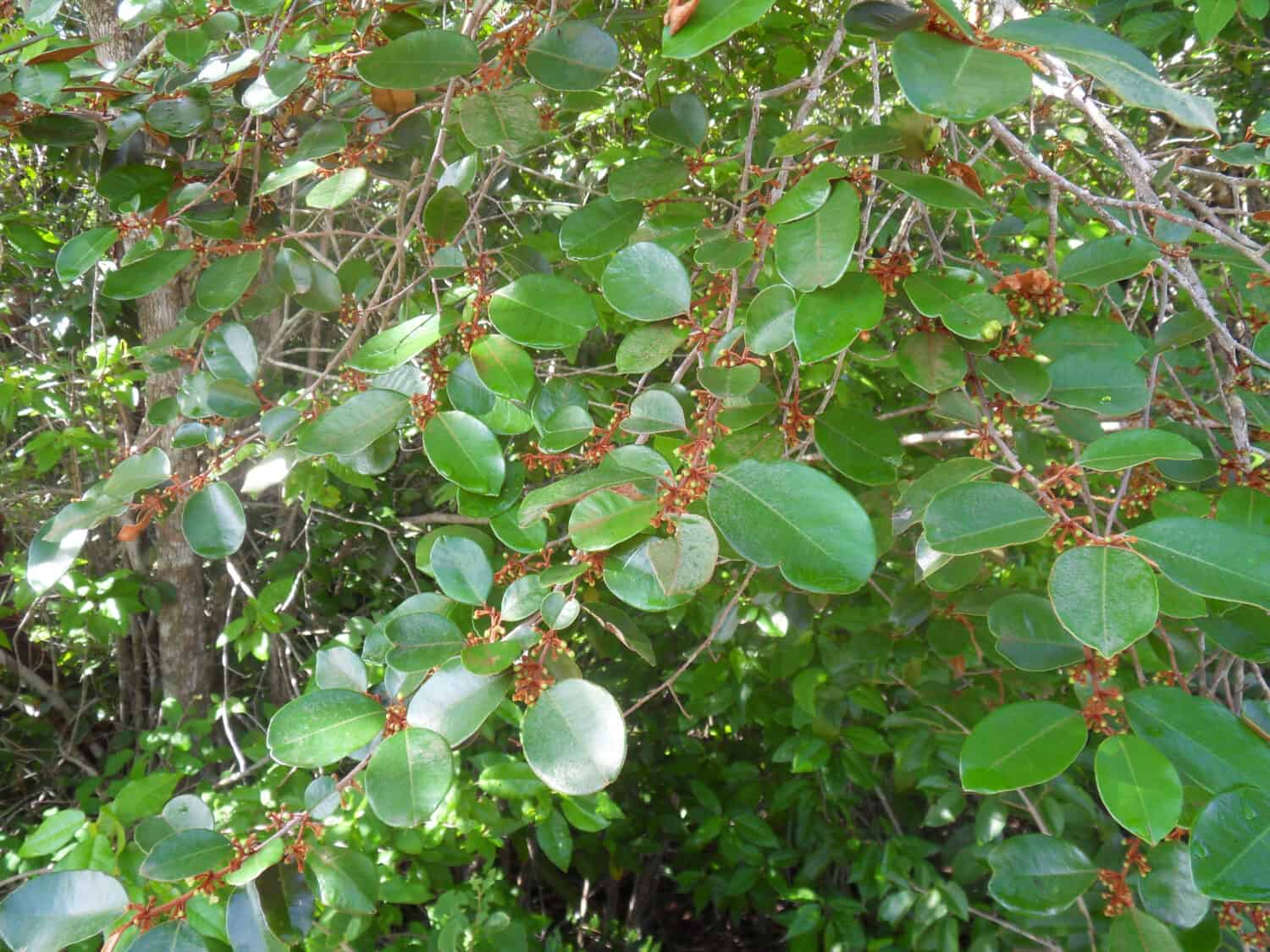
The satinleaf gets its name from the contrast between the dark green upper surface and the copper bottom surface of its leaves.
©Yundengogo/Shutterstock.com
The first tree on our list is the satinleaf (Chrysophyllum oliviforme), a native of Florida, the Bahamas, the Greater Antilles, and Belize. It has other names, such as the damson plum, wild star apple, and saffron tree. The satinleaf gets its name from the contrast between the dark green upper surface and the light brown or copper lower surface of its leaves, specifically how they ripple in the wind. The satinleaf produces small, creamy yellow flowers followed by edible, purple, or black fruits that resemble olives. The fruits are technically edible but known to be extremely chewy. It is a slow-growing tree that can reach up to 45 feet in height. It has a thin, scaly bark that is reddish-brown in color. The satinleaf is a popular ornamental tree for lawns and parks; however, it’s sensitive to cold, and frost may damage it during temperatures under freezing.
Sandalwood (Santalum spp.)
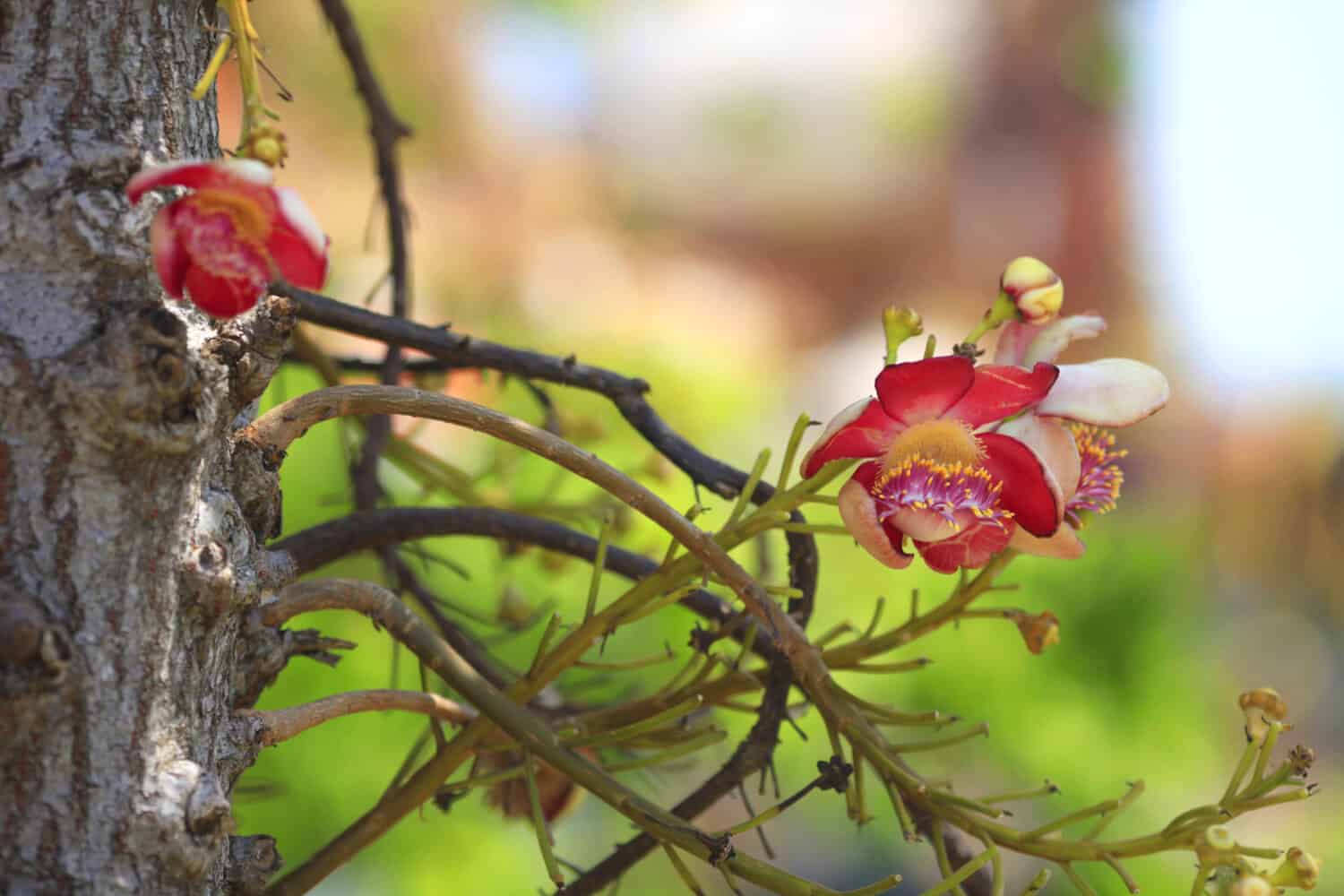
The sandalwood’s name comes from the Sanskrit word candana, which means “wood for burning incense.”
©Mirshik/Shutterstock.com
The next tree on our list is the sandalwood (Santalum spp.), a genus of about 25 species of semiparasitic trees that are native to Southeast Asia, Australia, and the Pacific Islands. Sandalwood is famous for its incredible smell and valuable wood and oil. For centuries, people have used this tree in perfumes, cosmetics, medicines, religious ceremonies, and more. Sandalwood oil is extracted by distillation of the heartwood, the innermost part of the trunk. The oil has a sweet, woody, and spicy aroma that can last for years. Sandalwood trees are slow-growing and can reach up to 10 meters (33 feet) in height. Sandalwood trees are partially parasitic, meaning they attach their roots to other plants and obtain some nutrients from them. The most common and widely used species of sandalwood is Santalum album, also known as Indian sandalwood or white sandalwood. This species is native to both India and Indonesia but is endangered due to its demand. Other species of sandalwood include Santalum spicatum (Australian sandalwood), Santalum paniculatum (Hawaiian sandalwood), and Santalum yasi (Fijian sandalwood).
Sapodilla (Manilkara zapota)
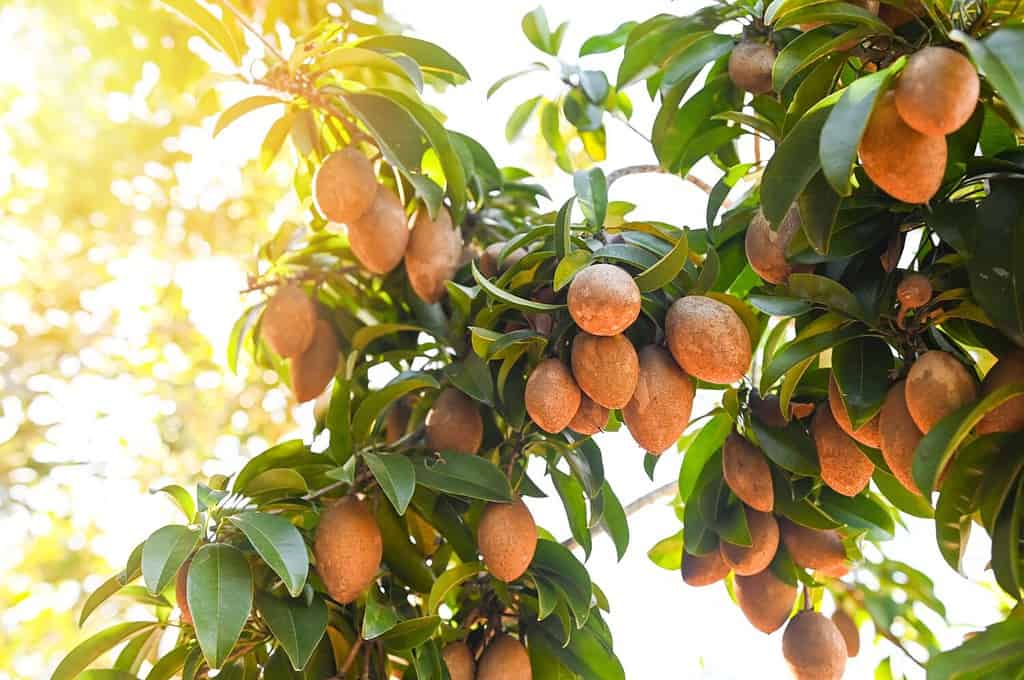
The sapodilla derives from the Spanish word zapote, which comes from the Nahuatl word tzapotl, meaning “soft fruit.”
©Bigc Studio/Shutterstock.com
The third tree on our list is the sapodilla (Manilkara zapota), an evergreen tree native to southern Mexico, Central America, and the Caribbean. It goes by various names, such as sapote, chicozapote, chicle, naseberry, or nispero. The sapodilla tree can grow up to 98 feet tall, but is usually smaller when human-cultivated. It has a thick trunk with a white, gummy latex called chicle, which was once used as a source of chewing gum. The fruit is a brown oval berry, about 2-4 inches in diameter. The fruit is edible and may be eaten fresh. You can also make it into jams, desserts, or drinks. The sapodilla tree is super resilient and grows in various soil and climatic conditions, and can tolerate drought and salt spray.
Seagrape (Coccoloba uvifera)
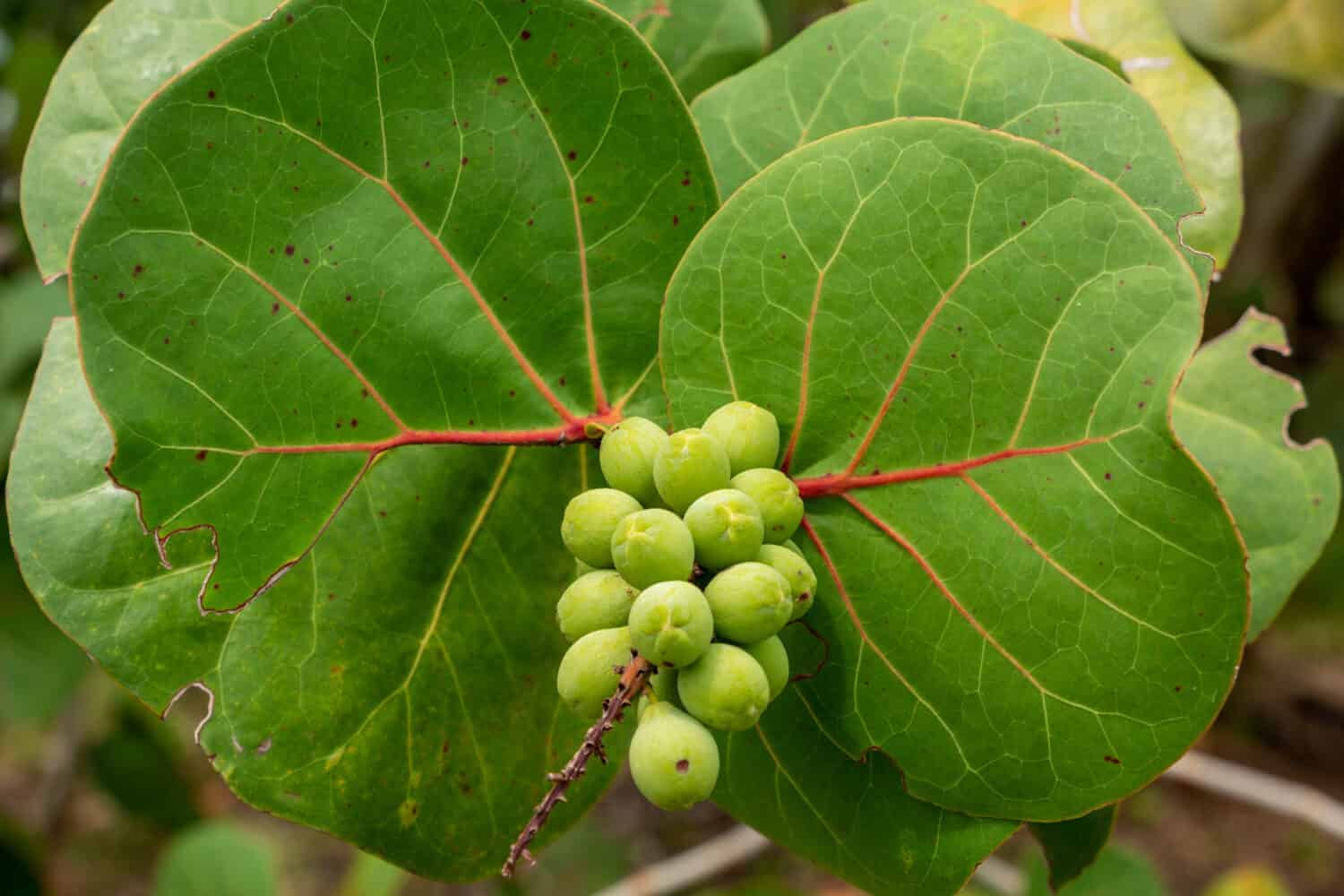
The seagrape’s name is from its grape-like fruits that grow near the sea.
©Sunshower Shots/Shutterstock.com
The fourth tree on our list is the seagrape (Coccoloba uvifera), a tropical evergreen tree that grows along the coastal beaches of southern Florida, the Caribbean, Central America, and northern South America. Another name for it is uva de playa, uvero, or raisin bord de mer. The seagrape tree has large, round leaves that are green on top and red underneath with light red veins. Seagrapes produce green fruits that look like grapes and turn purple when ripe (hence the name). The fruits are edible and have a sweet and sour taste. They can be eaten fresh or made into jams, jellies, or wines. The seagrape tree is a hardy and salt-tolerant plant. It is often planted as a windbreak, hedge, or ornamental tree in seaside landscapes. It is also a valuable plant for stabilizing sand dunes and preventing erosion.
Sycamore (Platanus spp.)
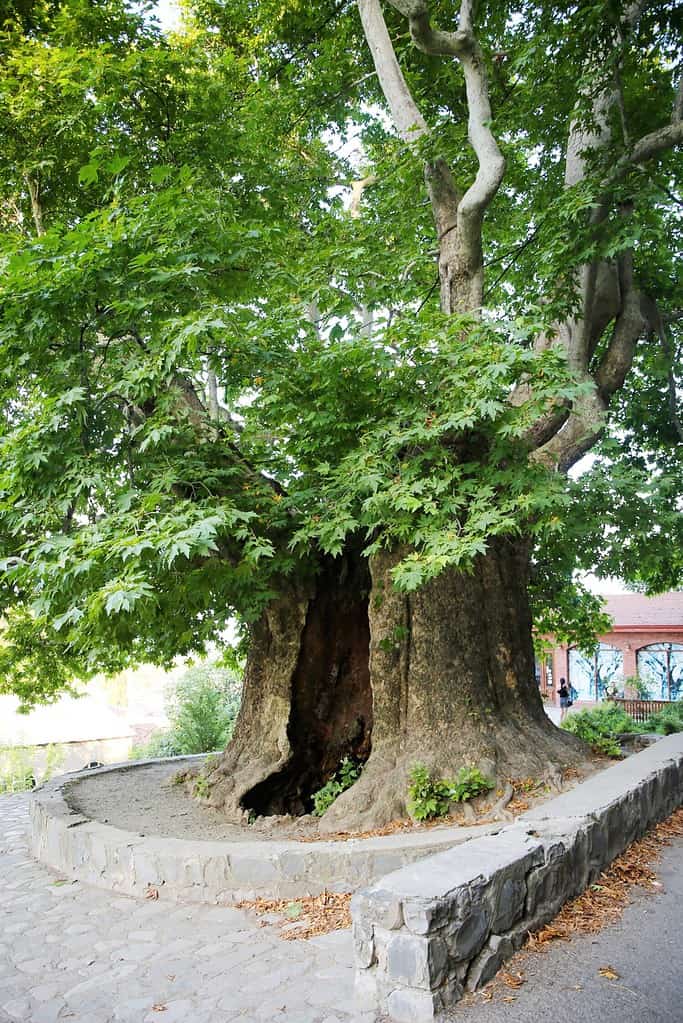
The sycamore derives from the Greek word sykomoros, which means “fig-mulberry”, and refers to its resemblance to those trees.
©Olga Geo/Shutterstock.com
The fifth tree on our list is the sycamore (Platanus spp.), a genus of large deciduous trees that belong to the plane-tree family. There are about six species of sycamore trees native to different regions of the world. The most common sycamore tree in North America is the American sycamore (Platanus occidentalis), which grows mainly in the eastern and central parts of the United States. The sycamore tree has distinctive bark that peels off in large patches, revealing a whitish or orangey inner bark. The leaves turn yellow and brown in autumn and fall off, something characteristic of deciduous trees. The fruits are spherical, brown, and hairy, containing lots of tiny seeds. The fruits hang on long stalks and last through winter. The sycamore tree is a fast-growing and hardy tree that can tolerate a wide range of soil and climatic conditions. It is often planted as a shade tree, street tree, or park tree. It is also valued for its wood, often used in furniture, instruments, and butcher’s blocks.
Spruce (Picea spp.)

The spruce is derived from the Old French word pruce, which means “from Prussia”, where the tree was first imported to Europe.
©KawaiiS/Shutterstock.com
The sixth tree on our list is the spruce (Picea spp.), a genus of about 35 species of evergreen trees in the pine family. Spruce trees are native to the northern temperate regions of the world, especially in Europe, Asia, and North America. These trees have a pyramidal shape and have leaves that are needle-like. They are valued for their wood, which is strong, light, and resilient. Spruce wood is used for construction, furniture, instruments, paper, and pulp. Spruce trees are also popular as ornamental trees, Christmas trees, and even bonsai plants. Some spruce species have medicinal properties and are used to treat respiratory infections, rheumatism, and skin problems.
Sweetgum (Liquidambar styraciflua)

The sweetgum is named after its aromatic resin or gum that leaks from the bark when the tree is wounded.
©iStock.com/sundry photography
The seventh tree on our list is the sweetgum (Liquidambar styraciflua), a deciduous tree native to the southeastern United States, southern Mexico, and Central America. The sweetgum is a tall tree that can reach up to 120 feet in height and 4 feet in diameter. The fruits are hard, spiny balls that hang on long stalks and contain seeds. The fruits persist through winter and can be a real pain when they fall on the ground. The sweetgum produces a fragrant resin that comes from the bark when wounded. The resin has been used for various purposes, including chewing gum, medicine, incense, and glue. Just don’t step on the seeds!
Silver Maple (Acer saccharinum)

The silver maple’s name originates from the silvery-white color of its lower leaf surface and its bark.
©iStock.com/Marina Denisenko
The eighth tree on our list is the silver maple (Acer saccharinum), a deciduous tree native to the eastern and central United States and southeastern Canada. It has a grayish-brown bark that becomes shaggy with age. The leaves are light green on the upper surface and silvery-white on the bottom, giving the tree its common name. The leaves turn yellow or brown in autumn and fall early. The fruits are winged and hang in pairs. They are commonly referred to as “helicopters” due to how they spin when dropped. It is often planted as a shade tree, street tree, or lawn tree, but it has some drawbacks, such as weak wood, shallow roots, storm damage, and invasive tendencies.
Serviceberry (Amelanchier spp.)
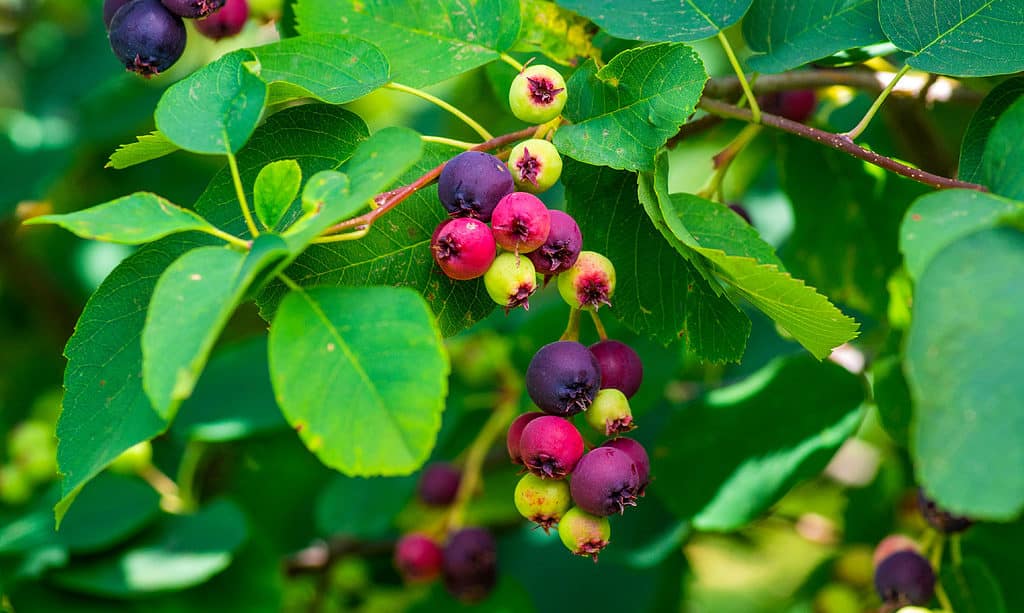
The serviceberry is named after the fact that its flowers appear in early spring when the ground was soft enough for burial services in the past.
©Iva Vagnerova/Shutterstock.com
The ninth tree on our list is the serviceberry (Amelanchier spp.), a genus of about 20 species of deciduous trees or shrubs native to North America. Serviceberries are also known by various other names, such as shadbush, shadblow, juneberry, saskatoon, or sarvisberry. The name “serviceberry” refers to the fact that the flowers appear in early spring, right around when the ground was soft enough for burial services in the older times (before modern tools for digging). The other common names, shadbush or shadblow, comes from how shad (a type of fish) run and spawn in rivers at the same time as the flowers bloom. The fruits are small, round, and purple or black, resembling blueberries. The fruits are edible and have a sweet profile. They can be eaten fresh or used for jams, pies, or wines. Birds and other wildlife also enjoy them.
Sitka Spruce (Picea sitchensis)

The Sitka spruce is named after Sitka, a city in Alaska, where it’s plentiful and native.
©iStock.com/Brittany Olson
The last on our list of trees that start with “S” is the Sitka spruce (Picea sitchensis), an evergreen tree native to the west coast of North America, from Alaska to northern California. The Sitka spruce is the largest of the world’s spruces and one of the tallest conifers, reaching 330 feet in height and 16 feet in diameter. The Sitka spruce grows in a maritime climate (near water) with abundant moisture, mild winters, and cool summers. It is often found along the coast, on islands, or near rivers and streams. The Sitka spruce is an important timber tree for lumber, pulp, and even instruments. It is also valued for its resin, which has industrial uses. The Sitka spruce provides habitat and food for many wildlife species.
A Larger List of Trees That Start With S:
Here is a more comprehensive list of trees that start with S:
- Satinleaf (Chrysophyllum oliviforme)
- Sandalwood (Santalum spp.)
- Sapodilla (Manilkara zapota)
- Seagrape (Coccoloba uvifera)
- Sycamore (Platanus spp.)
- Spruce (Picea spp.)
- Sweetgum (Liquidambar styraciflua)
- Silver Maple (Acer saccharinum)
- Serviceberry (Amelanchier spp.)
- Sitka Spruce (Picea sitchensis)
- Scarlet Oak (Quercus coccinea)
- Sago Palm (Cycas revoluta)
- Sal Tree (Shorea robusta)
- Sapele (Entandrophragma cylindricum)
- Sassafras (Sassafras albidum)
- Sausage Tree (Kigelia africana)
- Sequoia (Sequoiadendron giganteum)
- Sugarberry (Celtis laevigata)
- Sapotaceae (Family of tropical trees and shrubs)
- Salicaceae (Family of willows and poplars)
- Sapindaceae (Family of soapberries)
- Shadbush (Amelanchier canadensis)
- Saguaro (Carnegiea gigantea)
- Sal Tree (Shorea robusta)
- Siberian Elm (Ulmus pumila)
- Silk Tree (Albizia julibrissin)
- Silver Birch (Betula pendula)
- Silver Linden (Tilia tomentosa)
- Silverbell (Halesia spp.)
- Smoke Tree (Cotinus coggygria)
The photo featured at the top of this post is © Sunshower Shots/Shutterstock.com
Thank you for reading! Have some feedback for us? Contact the AZ Animals editorial team.







